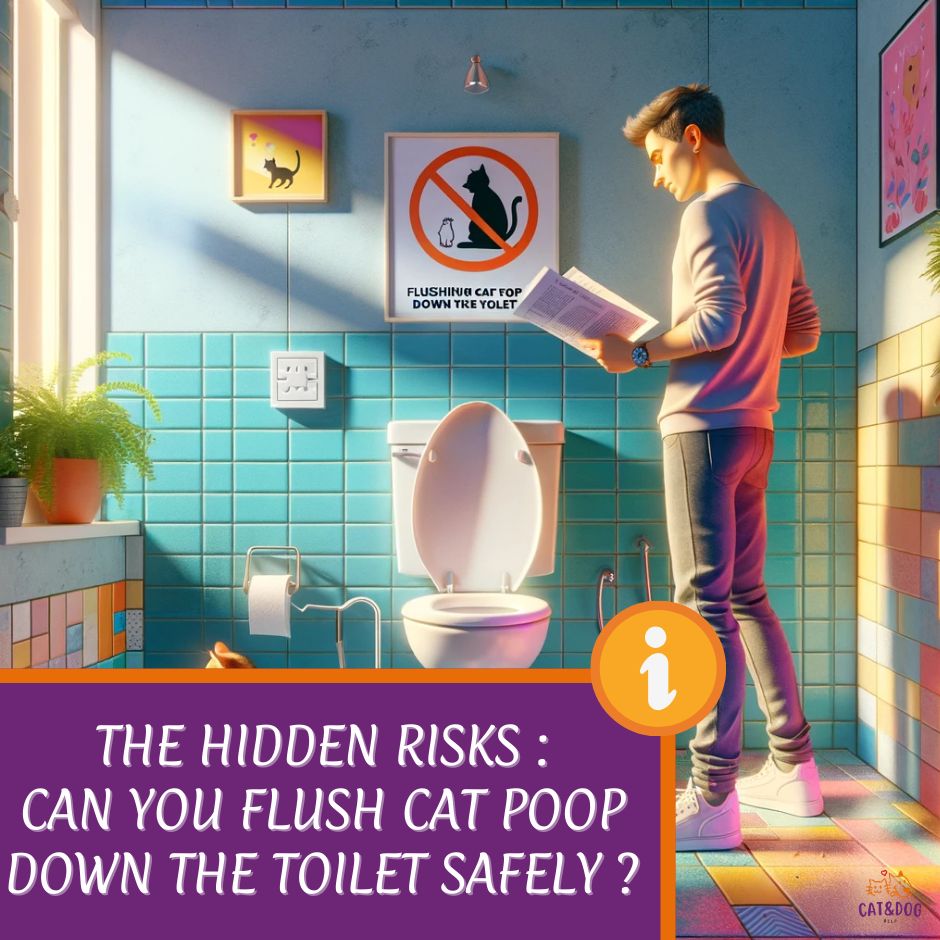Many cat owners wonder, “Can you flush cat poop down the toilet?” believing it to be a straightforward and environmentally friendly option, particularly with the advent of flushable cat litter.
However, it’s crucial to understand that flushing cat litter, or even cat feces, down the toilet, is not a safe practice.
This approach can cause significant clogs and damage to both plumbing and septic systems. Dive into the details below to discover the gritty, sh*tty reasons why flushing cat litter is a bad idea. (1)
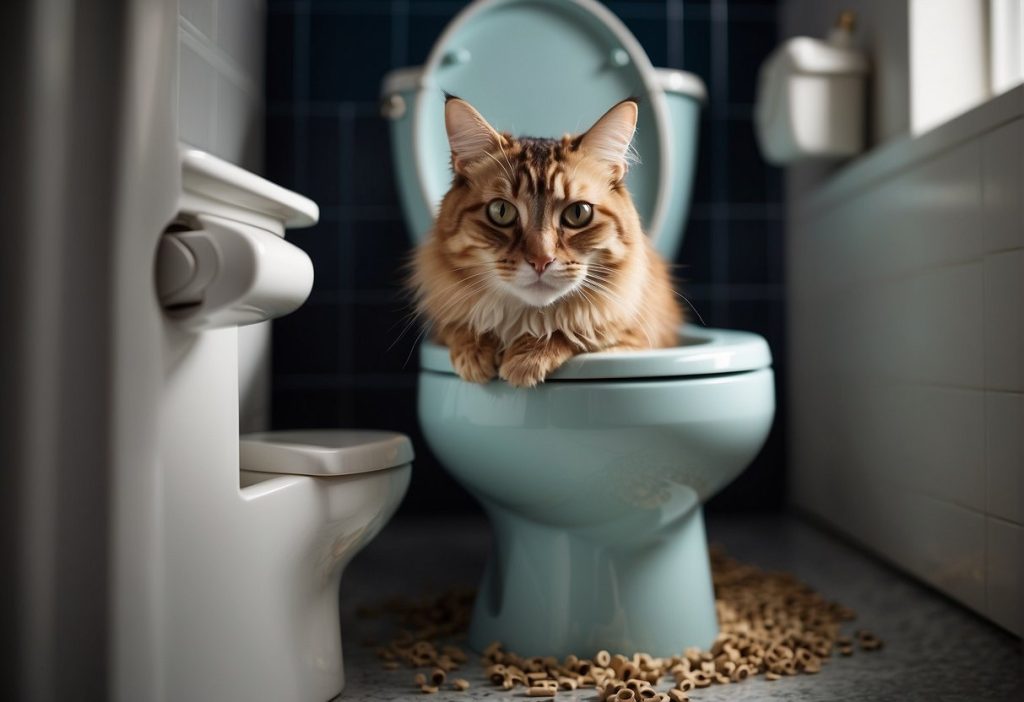
Despite the convenience it would offer, flushing cat poop and litter down the toilet is not as safe or harmless as it may seem.
This article unpacks the reasons why it could be a significant misstep. We’ll explore the potential health risks to humans and animals, and the environmental cost, and heed expert advice.
We won’t just leave you hanging with the problem; we also discuss practical and responsible alternatives for cat waste disposal, including composting with biodegradable cat litter and disposing of feces in the sewer, which is a good idea according to experts.
And yes, it’s about getting the community onboard, because responsible pet ownership is a group effort.
So relax, we’re about to guide you through keeping your home clean and our environment safer by properly disposing of cat waste in the sewer.
Key Takeaways
- Flushing cat poop can lead to health and environmental risks.
- Experts advise against flushing cat waste due to the potential spread of harmful parasites.
- Responsible disposal methods and community awareness are essential for proper cat waste management.
Understanding Can You Flush Cat Poop Down the Toilet
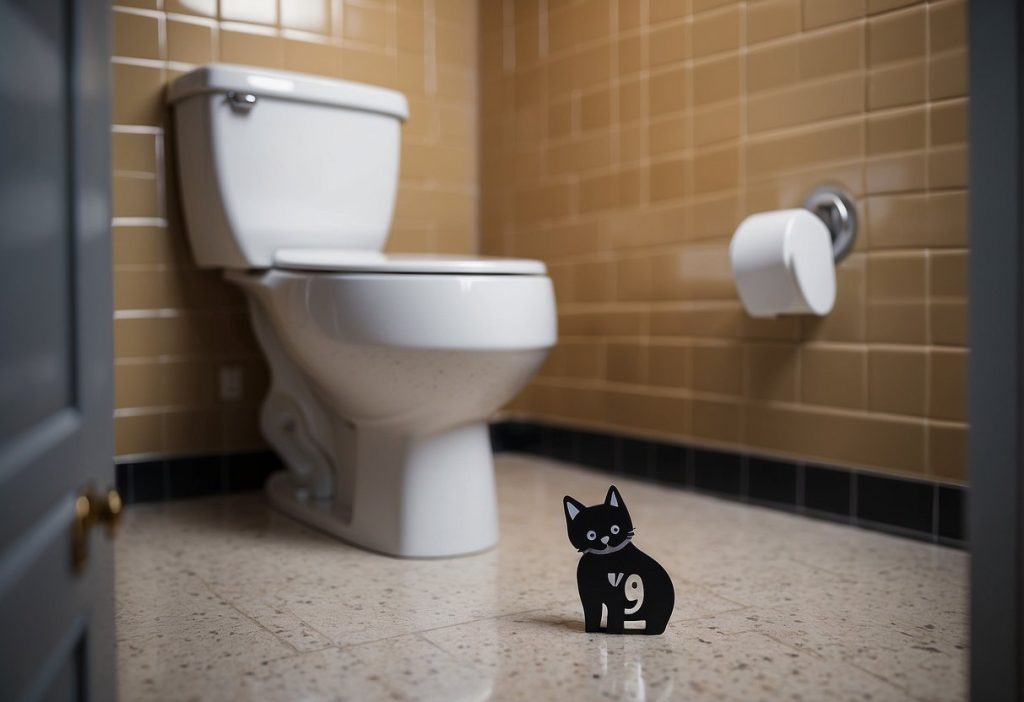
Health Hazards Associated with Toxoplasmosis
Cat feces can carry a parasite named Toxoplasma gondii, the culprit behind toxoplasmosis. (2)
This condition is no walk in the park, especially for pregnant women and those with weakened immune systems, as it can lead to serious health issues.
- For Expectant Mothers: The risks include birth defects and miscarriage.
- Immunocompromised Individuals: The effects can be severe, sometimes even fatal.
While statistics on actual toxoplasmosis cases linked to cat feces are not specified in the instructions, it’s acknowledged that the connection is significant enough to warrant caution.
Plumbing Issues and Environmental Impact: Ever wonder what happens to those clumps of litter? Besides not mixing well with your chic bathroom decor, they can clog your pipes.
Yep, cat litter is designed to clump on contact with moisture, and it expands to many times its original size, hardening like cement.
This can lead to costly plumbing issues, and if you’re not careful, you may end up having to pay plumbers to clean your pipes. Hello, plumbing nightmares!
Quick Facts:
- Standard plumbing isn’t meant for cat waste.
- Water treatment plants can’t effectively filter out toxoplasmosis, risking our waterways.
So you’re probably thinking, “Surely modern systems can handle a little kitty litter?”
Well, once those nasties from cat poop enter the sewage system, they might bypass the treatment process and head straight into rivers and oceans, putting marine life in jeopardy.
In short, it’s not just a crappy situation for your plumbing—it’s an environmental hazard too!
By keeping cat waste out of the toilet, you’re doing your pipes and the planet a huge favor. Keep it simple, bag it up, and bin it—the fish will thank you!
Expert Advice on Cat Waste Management
Let’s dig into what the experts have to say about this.
Dr. Felicity Furrball, a reputed veterinarian with a decade in feline medicine, advises against flushing cat poop down toilets. “Plumbing systems are not kitty litter boxes,” she quips.
Not only can it lead to clogs, but there’s also an environmental tale to this.
Toxoplasma gondii, a parasite found in cat feces, is a marine life menace that’s impervious to most water treatment systems and can harm our environment and waterways.
This is the main reason why it is important to properly dispose of cat poop in a designated waste bin to prevent contamination of our water systems.
Now, you may wonder what to do with it instead. Here’s a purrr-fect strategy:
- Biodegradable Bags: Use these eco-friendly options to bag up the litter.
- Dispose of it in your regular trash (yes, the weekly curbside pickup).
Remember, ‘out of sight’ doesn’t mean ‘out of environment’. Without sounding like a broken record, let’s note that proper cat waste management is critical for health—yours, your pet’s, and the planet’s.
Did you know that using biodegradable bags is not just about being eco-conscious? It’s also about reducing the risk of spreading that pesky T. gondii.
Dr. Earthlover, an environmental protection expert, stresses regular trash disposal to prevent any health risks to us and any critters who might stumble upon it.
So, while we adore our whiskered companions, let’s keep their waste out of our waterways and in the right place. Keep it clean, green, and serene, fellow cat enthusiasts!
Environmental Considerations
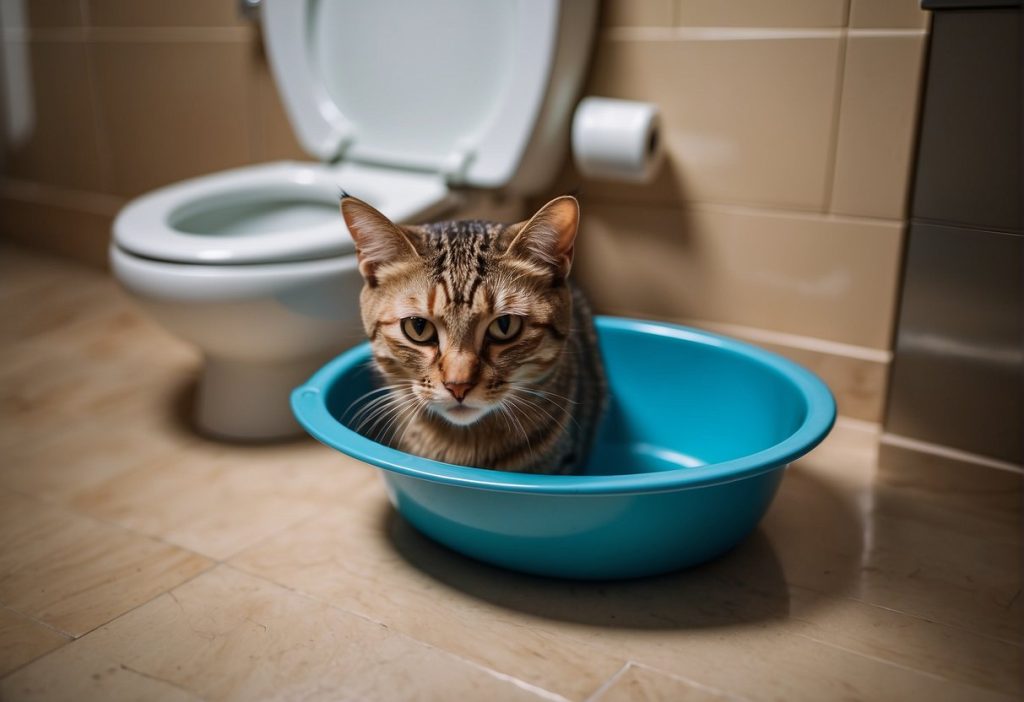
It may seem like a disappearing act, but the reality is that cat poop can have a serious impact on the environment, especially on local waterways and marine life.
- Toxoplasmosis Threat:
Cat feces often contain Toxoplasma gondii, a pesky parasite that causes the disease toxoplasmosis. When flushed, it can survive wastewater treatment and end up in local water bodies. (3) - Wildlife Risk:
This parasite poses a real threat to marine life. Studies have found that sea otters and other marine animals can be infected by T. gondii, leading to harmful consequences for these species.
| Effects on Marine Life | Details |
| Infection | Toxoplasmosis can cause inflammation and disrupt normal behavior. |
| Mortality | In severe cases, the parasite can be fatal to animals like sea otters. |
You might be thinking, “It’s just a little bit of poop, right?” However, the cumulative effect of many cat owners doing the same thing can lead to an environmental concern.
The key takeaway here is that you’re not just flushing away a small problem—you’re potentially contributing to a larger issue that can affect entire ecosystems.
Additionally, using a water-saving toilet may not provide enough water to properly flush cat feces and litter away, making it even more important to dispose of it properly.
It is important to ensure that you have enough water in your toilet to effectively flush away cat waste.
Remember, every flush is a choice with a ripple effect. Now, you’re armed with the knowledge to make a decision that protects our furry friends and the environment they—and we—live in.
So let’s keep those waterways clear and avoid using the toilet as a shortcut for cat waste disposal. Remember to only flush wastewater and toilet paper to prevent clogs and protect the environment.
Together, we can make a difference in our daily habits, even down to the type of toilet paper we use.
Practical Solutions for Cat Owners
Biodegradable Litters and Disposal
Let’s explore eco-friendly biodegradable litters that are not just good for your furry friend but also for Mother Earth:
- Corn Litter: Absorbent and biodegradable, it’s made from natural corn kernels.
- Wheat Litter: It clumps well and neutralizes odors naturally.
- Pine Litter: Pine pelts are known for their fresh scent and compostability.
Their benefits? These litters decompose without leaving harmful residues behind.
- Check local regulations to ensure composting pet waste is allowed.
- Scoop daily, separating waste from the litter.
- Compost cat waste separately from your regular compost, and only use it on non-edible plants.
Innovative Disposal Methods
It’s a green thumb’s dream for your garden’s non-edible plants, but remember to:
- Never use this compost for fruits, veggies, or herbs.
- Keep the compost away from watercourses to prevent contamination.
Too busy to DIY? Consider a commercially available litter disposal system.
These gadgets promise to make life cleaner and greener, but weigh the pros and cons:
- Pros: Effective odor control, less waste, and convenient.
- Cons: Initial costs might be higher, and replacements or refills may be needed.
A quick tip: Look for disposal systems compatible with biodegradable litters to up your eco-game.
It’s about finding that sweet spot, where convenience meets responsibility. Remember, a little change in your litter routine can make a big impact!
Engaging the Community

Many cat owners face the daily conundrum of cat waste disposal, specifically when it comes to cleaning out their cat’s litter box.
Let’s make this less of a solitary struggle and more of a group effort by engaging the community in discussions about the best ways to dispose of cat poop, such as using a plastic bag, and maintaining a clean cat litter box.
Whether it’s using biodegradable bags or finding eco-friendly alternatives, let’s work together to keep our homes and the environment clean.
Share Your Tail Tales
Drop us a line and let the community in on your secret. It’s all about the pawsitive impact we can have when we share our stories.
- Janet from Florida writes, “I used to flush my cat’s waste until I learned about the environmental risks.
Now, I compost it in a designated area and use it for non-food plants. It’s easy and eco-friendly!“ - Lucas and his tricked-out litter box in Texas: “After dealing with clogged pipes, I switched to biodegradable litter and started using a lined waste bin that I empty weekly. It’s a game-changer!“
Are you up for a little cat chatter? Tell us how you’ve nixed the flush and opted for a greener route. No story is too small when it comes to inspiring others and keeping our environment clean!
Why This Matters
Handling cat waste the right way—yours, Janet’s, Lucas’, or any method that avoids those pesky plumbing problems—is not just about our convenience.
It’s about keeping our waterways toxin-free and our four-legged companions safe and happy. Plus, who wouldn’t want to avoid an unexpected plumbing catastrophe?
Ready to Dish?
Remember, there’s no one-size-fits-all solution here. It’s all about finding what works for you and your fuzzy sidekick—and sharing that knowledge could be someone else’s litter lifesaver!
Quick Recap
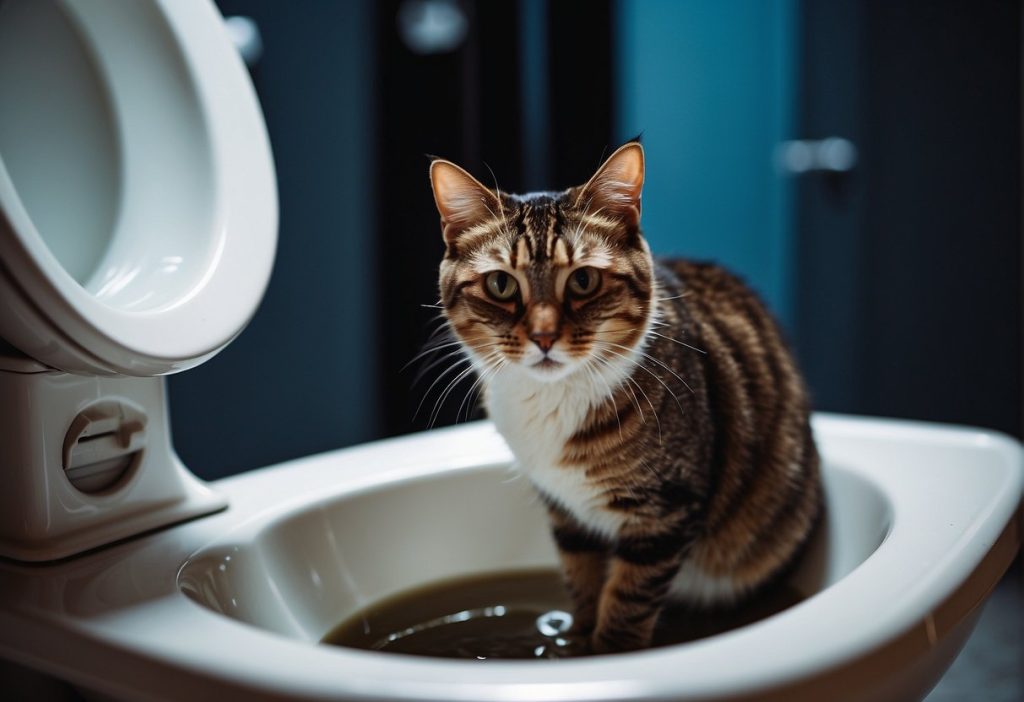
Here’s a brief roundup of what you need to know to avoid any bathroom blunders:
- Environmental Concerns:
Flushing cat feces potentially introduces parasites like Toxoplasma gondii into the water system. These can bypass water treatment processes and harm wildlife. (4) - Expert Recommendations:
Instead of flushing, experts suggest disposing of cat waste in a manner that aligns with community standards and local regulations. - Community Solutions:
Discuss with your local waste management authority for best practices, since rules can vary. - Safe Disposal:
Use eco-friendly methods of disposal whenever possible. (5)
Remember, being a responsible pet owner means considering the impact your cat’s waste can have on your surroundings.
Share your experiences with the community. Your insights could be a game-changer! 🐾
Frequently Asked Questions
Here’s the scoop on how to handle cat poop, touching on health, eco-friendliness, and the ins and outs of cat litter management.
Is it ever safe to flush cat poop down the toilet?
No, it’s not safe. Flushing cat poop can introduce harmful pathogens like toxoplasmosis into water systems which aren’t always treated for such parasites.
Plus, you’re risking your plumbing with potential blockages.
Can toxoplasmosis in cat poop harm humans?
Toxoplasmosis is a serious concern.
This parasite can cause health issues in humans, especially pregnant women and individuals with compromised immune systems.
It’s a big reason why flushing cat poop is a no-go.
What are the best types of biodegradable cat litter?
Looking for a green solution? Biodegradable cat litter made from recycled paper, wood, wheat, or corn is your best bet.
They break down easily and are less harmful to the environment.
How can I dispose of cat poop without harming the environment?
Eco-friendly disposal is key. Seal the poop in biodegradable bags before tossing in the trash.
Composting is an option too, but ensure it’s done safely to avoid contaminating soil with pathogens.
Can flushing cat poop damage my plumbing?
Yes, it can clog your pipes and wreak havoc on your sewage system or septic tank.
Cat litter is designed to clump and absorb moisture, characteristics you don’t want in your plumbing.
Are there any pet-friendly alternatives to traditional cat litter?
You bet! Pet-friendly litters are available that use materials like recycled paper or wood shavings. They’re easier on your cat’s paws and better for the planet.
How often should I clean my cat’s litter box?
For a happy cat and a fresh home, scoop daily and change the litter entirely at least once a week.
A clean litter box means a clean bill of health for everyone.

